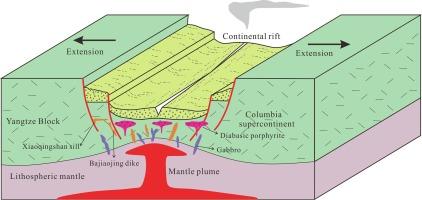Late Paleoproterozoic within-plate mafic magmatism in the western Yangtze Block, South China Craton: Implications for the initial break-up of the Columbia supercontinent
IF 3.2
2区 地球科学
Q2 GEOSCIENCES, MULTIDISCIPLINARY
引用次数: 0
Abstract
The Paleoproterozoic was an important period for the tectonic-magmatism evolution of the Yangtze Block, which coincided with the assembly and break-up of the global Columbia (also known as Nuna) supercontinent. However, an essential issue, when the Yangtze Block initiated rifting from the supercontinent, remains controversial. This paper presents new zircon chronology, Lu-Hf isotopic data, and whole-rock geochemical analyses of the Bajiaojing and Xiaoqingshan meta-diabases in the western Yangtze Block to address this issue. The magmatic zircons from the Bajiaojing and Xiaoqingshan meta-diabases yielded U-Pb ages of 1675 ± 38 Ma and 1719 ± 10 Ma, representing an episode of mafic magmatism during the Late Paleoproterozoic. Moreover, the abundances and elemental ratios of high-field-strength elements (HFSEs, e.g., Y, Ta, Th, and Hf) in both meta-diabases are very similar to those of within-plate and mantle plume magmas. This implies that these Late Paleoproterozoic mafic rocks were likely derived from a mantle plume source in a continental within-plate extensional setting. Their magmatic source was relatively heterogeneous in isotopic and geochemical compositions, as inferred from significant differences in εHf(t) values and certain HFSE ratios (e.g., Nb/Yb, Ta/Yb, Th/Yb, Nb/Y, and Zr/Y) among samples. Such source heterogeneity might be attributed to interactions between the mantle plume and the overlying lithosphere. Combined with published εHf(t) values of detrital zircons and whole-rock εNd(t) values of (meta-)magmatic rocks, we speculate that the Yangtze Block experienced a tectonic transition from plate convergence to continental extension at ∼ 1.7 Ga. This means that the block began to rift from the Columbia supercontinent as early as 1.7 Ga. The Yangtze Block then evolved progressively as an isolated fragment until it was amalgamated into the Rodinia supercontinent.

华南克拉通西部扬子地块晚古新生代板内岩浆活动:对哥伦比亚超大陆最初解体的影响
古近古生代是长江地块构造-岩浆演化的重要时期,与全球哥伦比亚(又称努纳)超大陆的组装和解体相吻合。然而,长江地块何时从超大陆开始断裂这一重要问题仍存在争议。本文针对这一问题,提出了新的锆石年代学、Lu-Hf同位素数据,并对长江地块西部的八角井和小青山元气层进行了全岩地球化学分析。八角井和小青山元地层的岩浆锆石的U-Pb年龄分别为1675±38Ma和1719±10Ma,代表了晚古生代的一次岩浆活动。此外,两个元数据库中的高场强元素(HFSE,如Y、Ta、Th和Hf)的丰度和元素比与板内岩浆和地幔羽流岩浆的丰度和元素比非常相似。这意味着这些晚古新生代岩浆岩很可能来自板内大陆延伸环境中的地幔羽流。它们的岩浆源在同位素和地球化学成分方面相对异质,这可以从不同样品的εHf(t)值和某些HFSE比值(如Nb/Yb、Ta/Yb、Th/Yb、Nb/Y和Zr/Y)的显著差异推断出来。这种源异质性可能是由于地幔羽流与上覆岩石圈之间的相互作用造成的。结合已发表的非铁质锆石εHf(t)值和(元)岩浆岩的全岩εNd(t)值,我们推测扬子地块在1.7 Ga∼时经历了从板块汇聚到大陆延伸的构造转变。这意味着早在 1.7 Ga 时,该区块就开始从哥伦比亚超大陆裂开。随后,长江地块作为一个孤立的片段逐渐演化,直至与罗迪尼亚超大陆合并。
本文章由计算机程序翻译,如有差异,请以英文原文为准。
求助全文
约1分钟内获得全文
求助全文
来源期刊

Precambrian Research
地学-地球科学综合
CiteScore
7.20
自引率
28.90%
发文量
325
审稿时长
12 months
期刊介绍:
Precambrian Research publishes studies on all aspects of the early stages of the composition, structure and evolution of the Earth and its planetary neighbours. With a focus on process-oriented and comparative studies, it covers, but is not restricted to, subjects such as:
(1) Chemical, biological, biochemical and cosmochemical evolution; the origin of life; the evolution of the oceans and atmosphere; the early fossil record; palaeobiology;
(2) Geochronology and isotope and elemental geochemistry;
(3) Precambrian mineral deposits;
(4) Geophysical aspects of the early Earth and Precambrian terrains;
(5) Nature, formation and evolution of the Precambrian lithosphere and mantle including magmatic, depositional, metamorphic and tectonic processes.
In addition, the editors particularly welcome integrated process-oriented studies that involve a combination of the above fields and comparative studies that demonstrate the effect of Precambrian evolution on Phanerozoic earth system processes.
Regional and localised studies of Precambrian phenomena are considered appropriate only when the detail and quality allow illustration of a wider process, or when significant gaps in basic knowledge of a particular area can be filled.
 求助内容:
求助内容: 应助结果提醒方式:
应助结果提醒方式:


